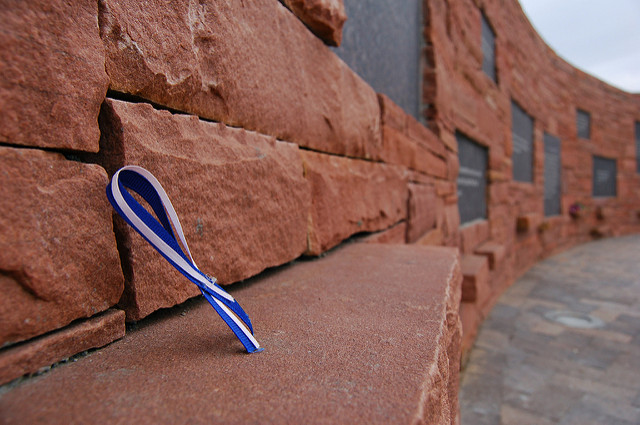
By Stephanie Shriver-Byrne, Staff Writer
Deadly school shootings shock and traumatize a community like nothing else. On Sept. 28, 2016, a 6-year-old boy was shot and mortally wounded while going outside to play for recess.[1] Unfortunately, school shootings have been part of America’s history,[2] but since the mass shooting of Columbine High School, more schools have become proactive in school shooter preparedness. One popular trend is to station armed guards at schools to deter a potential threat and stop an active shooter.
Since the Sandy Hook school shooting in 2012, schools across the nation have begun employing school police officers, or school resource officers, to protect students from school shootings. There have been recent instances which suggests that school resources officers — officers that have undergone school policing training and are often employed by a local police department — and school police officers — officers employed directly by the school — require further training to avoid excessive use of force. Data suggests that minority students and students with disabilities are at a higher risk of excessive force.[3]
The National Rifle Association created the National School Shield[4] in December 2012 for the purpose of promoting school safety, which entails accepting donations and providing grants to protect children. Current Arkansas governor and former Rep. Asa Hutchinson (R-AR), in the wake of Sandy Hook, suggested that the National School Shield program work to arm school personnel or hire more armed school resource officers.[5]
While the intention is for an armed school guard to stop a shooter, there is an increased risk of armed officers, who are untrained to work with children, using excessive force or working outside of the scope of their employment.
Some instances of school police officers using excessive force on students within the last 18 months include: a school police officer slapping and kicking a student[6]; a school police officer holding a student in a chokehold[7]; a school resource officer throwing student down and dragging her[8]; a school police officer slamming a student to the ground[9]; and a school resource officer handcuffing an 8-year-old special needs child by the elbows.[10]
School administrators are pressured to protect students from outside threats. Schools, however, also have limited funds to spend on adequately training officers for this specialized form of policing. Furthermore, most schools are not required to train the officers, not just on active shooter preparedness, but also on the implications of working with youth — as discussed by Nina Salomon, a senior policy analyst at the Council of State Governments Justice Center.[11]
Only 12 states have laws specifying the training that armed guards must attain before working in schools. Those states differ on training topics, such as understanding child development, how to respond with de-escalation techniques, and how to address students with special needs.[12] According to Susan Mizner, disability counsel for the ACLU, one of the biggest problems is that there is a lack of assertion on the part of the school administration that a school police officer’s job is not to administer discipline to routine behavioral problems.[13]
There is little data on how effective school police officers are at preventing school shootings. Nevertheless, a few examples of school resource officers stopping shootings within the last six years include: a school resource officer taking a gun away from a shooter[14]; a school resource officer pursuing a school shooter, who then committed suicide[15]; a school resource officer placing her body between a gunman and the principal, who deescalated the situation until police arrived — resulting in no injuries to students or staff.[16]
There is a balance to be achieved in protecting students from active shooters and shielding students from excessive force by armed guards. School administrators must decide on whether to spend money on armed guards — and in turn not spend money on educational initiatives. If school administrators do hire school police officers or school resource officers, they must be willing to spend the extra money for offering as much training as necessary to reduce the risk of excessive force.
Sources
[1] http://www.nytimes.com/2016/10/08/us/jesse-dewitt-osborne-south-carolina-school-shooting-jacob-hall.html
[2] See http://chroniclingamerica.loc.gov/lccn/sn84024738/1860-01-26/ed-1/seq-1/#
[3] http://www.theatlantic.com/education/archive/2015/11/why-do-most-school-cops-have-no-student-training-requirements/414286/
[4] https://www.nationalschoolshield.org/
[5] http://www.usnews.com/news/articles/2013/04/02/nra-school-shield-suggests-schools-arm-more-people
[6] http://abcnews.go.com/US/baltimore-school-police-officers-charged-assault-student-caught/story?id=37518067
[7] http://abcnews.go.com/US/baltimore-school-police-officers-charged-assault-student-caught/story?id=37518067
[8] http://www.nytimes.com/2016/09/03/afternoonupdate/deputy-who-tossed-a-sc-high-school-student-wont-be-charged.html
[9] http://kxan.com/2016/04/07/video-12-year-old-san-antonio-student-body-slammed-by-police/
[10] http://people.com/crime/kentucky-officer-handcuffs-a-crying-8-year-old-boy-with-disabilities-at-school/
[11] http://www.theatlantic.com/education/archive/2015/11/why-do-most-school-cops-have-no-student-training-requirements/414286/
[12] Id.
[13] Id.
[14] http://www.cbs46.com/story/20899352/police-student-shot-by-fellow-student-at-price-middle-school-in-atlanta
[15] http://www.cnn.com/2013/12/14/us/colorado-school-shooting/
[16] http://www.heraldcourier.com/news/gunman-killed-at-sullivan-central/article_35434f30-00d3-522f-98f1-58f372591713.html